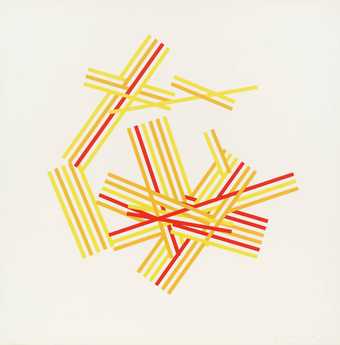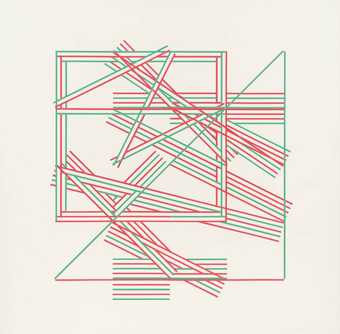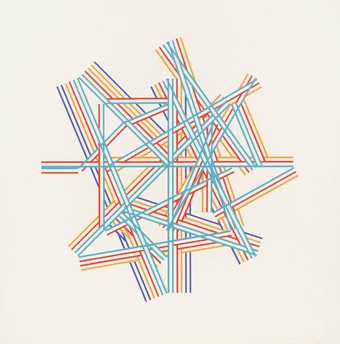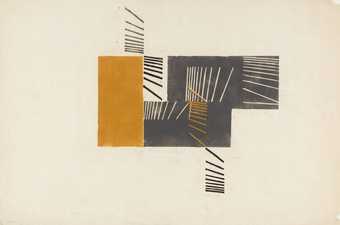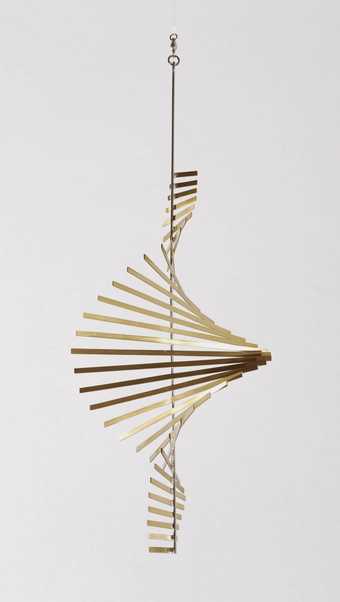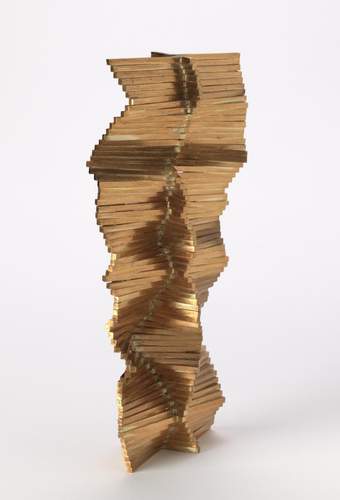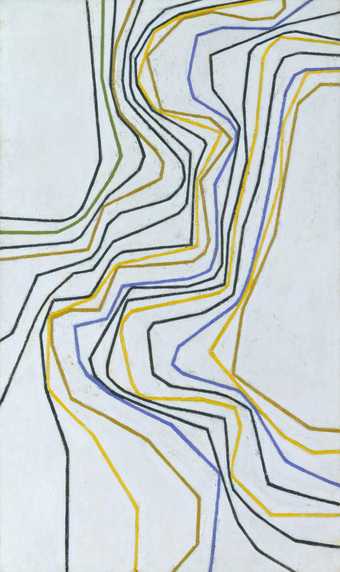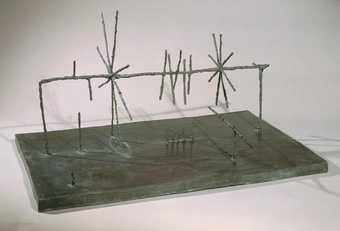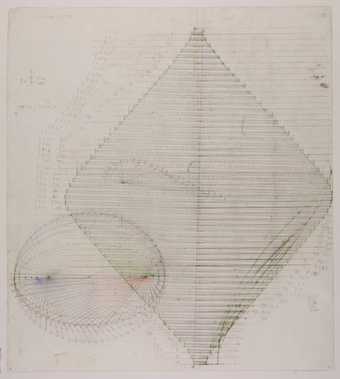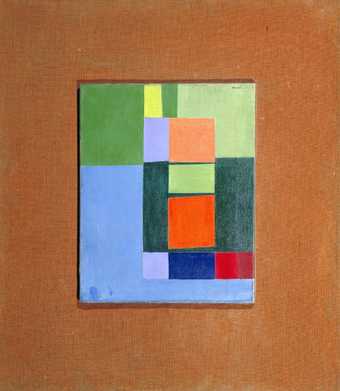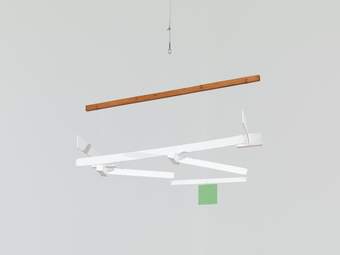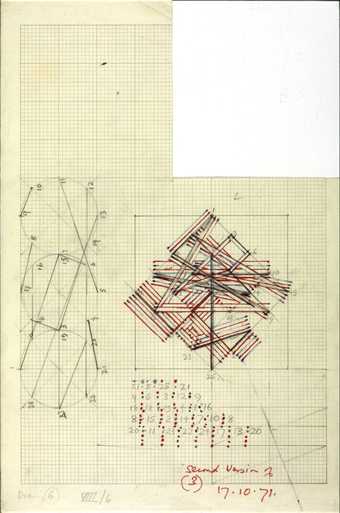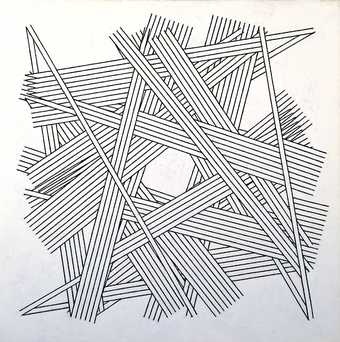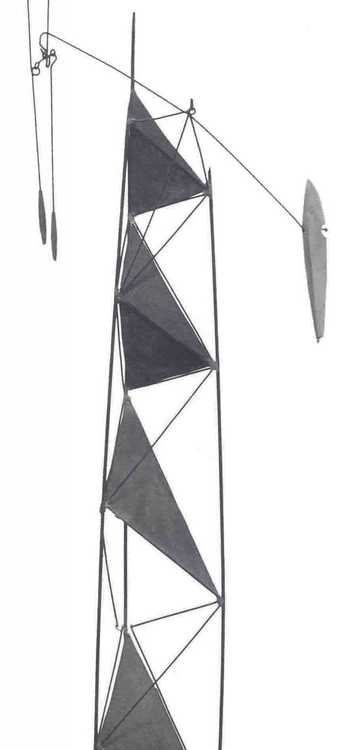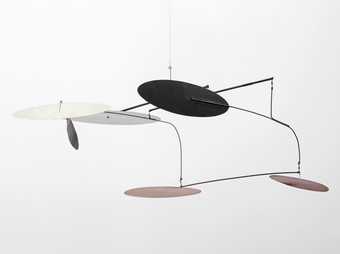In Tate St Ives
- Artist
- Kenneth Martin 1905–1984
- Medium
- Bronze and wood
- Dimensions
- Object: 279 × 629 × 629 mm. Height from hanging point 410mm.
- Collection
- Tate
- Acquisition
- Purchased 1965
- Reference
- T00752
Display caption
This mobile consists of two circular elements composed of bronze rods. They radiate from a black wooden 'hub' at the centre, in the shape of a cylindroid, and are joined at the outer rim. One of the elements is horizontal and oscillates from the centre. The second element rotates around the centre, and, through the twist, makes an endless surface. The strip of metal along the outside edge also makes an endless surface. Originally the mobile was rotated with an electric motor. Kenneth Martin wrote that the mobile was 'an essay in repetitive rhythm. It is like a landscape which rotates around its centre of perspective - though this simile must not be taken too far'.
Gallery label, September 2004
Does this text contain inaccurate information or language that you feel we should improve or change? We would like to hear from you.
Catalogue entry
T00752
Phosphor bronze and wood suspended mobile, 279 x 629 x 629 mm (11 x 24 3/4 x 24 ¾ in)
Purchased from the artist (Knapping Fund) 1965
Exhibited:
Essays in Movement: Reliefs by Mary Martin, Mobiles by Kenneth Martin, Institute of Contemporary Art, London, June-July 1960 (19)
Construction: England: 1950-60, Drian Gallery, London, January 1961 (not in catalogue)
Kenneth Martin: A Retrospective Exhibition, Lords Gallery, London, October-November 1962 (25)
Prix Château de la Sarraz, Maison des Artistes, Fondation Hélène de Maudrot, Vaud, Switzerland, June 1963 (no number)
British Sculpture in the Sixties, Tate Gallery, London, February-April 1965 (60, reproduced as ‘Screw Mobile 1960’)
Kenneth Martin, Tate Gallery, London, May-June 1975 (15, reproduced p.68 as ‘Screw Mobile with Black Centre, 1959-61’)
Literature:
Tate Gallery Report 1965-6, London 1966, p.37
Andrew Forge, ‘Some Recent Works by Kenneth Martin’, Studio International, vol.172, no.884, Dec. 1966, p.300
Reproduced:
Michael Compton, Optical and Kinetic Art, London 1967, pl.16
‘Nouvelles des Arts’, L’Oeil, no.238, May 1975, p.80
Screw Mobile with Black Centre is amongst Kenneth Martin’s more complex works of the late 1950s which depart significantly from such early helices as Small Screw Mobile (Tate T00552). It maintains the progressively ascending radiation of elements from a central hub, but this is restricted in elevation and is transformed by the introduction of a second series of elements which result in a different character. Martin specifically associated it with works such as Screw Mobile with Cylinder, 1956 (Arts Council collection, London)[1] and Screw Mobile, 1956-9 (Sir Allen Lane Collection).[2]
He summarised the structure of the Tate’s mobile:
Series of 2 joined rods. The horizontal one is oscillated around the black wood centre in the manner of a cylindroid while the other is rotated around it to make an endless surface. The strip of metal which encompasses the latter is also an endless surface. The work is an essay in repetitive rhythm. It is like a landscape which rotates around its centre of perspective - though this simile must not be taken too far.[3]
Michael Compton remarked of the Screw Mobiles in general: ‘Each work is conceived and executed from the centre outwards’.[4] In this case, the centre is the black painted wooden hour-glass form, which resembles the shape achieved by a progression of short lines around an axis seen in the related Screw Mobile, 1959 (formerly collection of Ashley Havinden).[5]
As Martin indicated, one series of rods extends to describe a circle, the circumference of which fluctuates evenly as a result of the ascent and descent of the rods’ sockets in the cylindroid. There are thirty-six phosphor bronze rods (set 10° apart), each 12 inches (305 mm) in length; they are soldered to a rim made of the same rod. In the second series there are also thirty-six rods of the same grade of phosphor bronze. They are free of the core, but are soldered to the first series of rods half way along their length. On one side they lie almost horizontal (so that the two series are parallel), but they are successively angled so that on the opposite side they approach the vertical. Between these extremes they have also been angled tangentially to the core, so that a complex curve is described. The edge of this second series is made of flat strips, of differing lengths, which are pierced by the rods where they overlap and are soldered. This technique distinguishes it from the rim of the first series and makes it easy to trace how it turns over towards the core, curving below and then emerging above, before returning to the perimeter. This describes the ‘endless surface’ mentioned by Martin, otherwise known as the Moëbius Ribbon or Strip; a physical paradox in which what appears to be an outside edge may be traced as continuous with what appears to be an inside edge. The differences are clearly defined on the mobile: the rod rim is attached to one end of all of the first series rods, while the flat links cross each end of all the second series rods in a continuous chain.
The whole mobile is fixed to the core (by the first series rods) and suspended by an axis. The latter is not quite vertical because of the asymmetry of the construction. It was linked to an electric motor which, as the artist confirmed to the Tate in May 1971, made it rotate at one revolution per minute.[6] The mobile has also been exhibited simply by suspension and without the motor. Martin also told the Tate:
I have come to feel that it should be seen at eye level and that its cast shadow is an integral part of it. Eye level enhances the rotation about a central perspective effect while the shadow reveals another aspect of its personality and emphasises rhythm.[7]
The effect of cast shadow is often seen in the photographs favoured by the artist.
Given the logic of the structure it is not clear why work on the mobile extended over such a long period. Despite the artist’s own assurance that it was ‘commenced 1958 (or thereabouts) and continued to be worked on until 1965’,[8] it appeared as ‘1959-61’ in his Tate solo exhibition a decade later. It was exhibited regularly in the early 1960s, suggesting that it was in a complete - if not definitive - form by the time of its inclusion in Essays in Movement in 1960 at the Institute of Contemporary Art in London.
In common with all of Martin’s Screw Mobiles, the structure was first worked out two dimensionally, in this case in Drawing for Screw Mobile with Black Centre, 1960 (New Orleans Museum of Art).[9] In the middle of this full scale drawing on graph paper the Moëbius Strip of the second series of rods is plotted; their central links to the first series are shown in plan as the central oval around which the lines are turned. Immediately above is a further drawing which is trimmed by the edge of the sheet and usually hidden under the mount; revealing the artist’s working methods, it shows the elevation of the same series of rods from which the central drawing was probably projected.
While the motorisation of the mobile recalls Naum Gabo’s Kinetic Construction (Standing Wave), 1919-22 (Tate T00827), the drawing recalls his nylon threaded works, one of the most familiar of which, Linear Construction, 1942-3, the Tate had acquired in 1958 (T00191). As distinct from Gabo’s determination of form by a linear development of the mathematical division of the framing elements - the curves created by the straight lines being a consequence - Martin’s form was plotted and projected from the core. Martin was also probably aware of Gabo’s Spherical Theme works,[10] which explored ‘one curved continuous surface’ - although they still retained two faces. However, it may have been the work of the Swiss Construcitvist Max Bill which encouraged Martin’s interest in the Moëbius Strip. Bill had begun to make works based on it in the 1930s, paradoxically using stone for his Ruban sans fin, 1965 (Thomas and Sonja Bata Collection, Don Mills, Ontario).[11] The Martins were in contact with him by 1960, when they contributed to Konkrete Kunst which he organised at the Zurich Helmhaus. Through Bill, Gabo and others, the Martins forged important links to pre-war Constructivism.
Matthew Gale
August 1996
[1] Reproduced in Arts Council Collection, London 1979, p.173.
[2] Reproduced in Kenneth Martin, exhibition catalogue, Tate Gallery, London 1975, p.64.
[3] Letter, 30 August 1965, Tate Gallery cataloguing files.
[4] Michael Compton, ‘Analysis of Selected Works’, in Andrew Forge and others, Kenneth Martin, London 1975, p.24.
[5]
Reproduced in Kenneth Martin exhibition catalogue, 1975, p.67, no.14.
[6] Martin, letter, May 1971, Tate Gallery cataloguing files.
[7] Martin, letter, 30 August 1965, Tate Gallery cataloguing files.
[8] Ibid.
[9] Gift of Mrs Edgar B. Sern, reproduced in Kenneth Martin exhibition catalogue 1975, p.65, no.25.
[10] Published in Herbert Read and Leslie Martin, Gabo, London 1957, pls.64,65.
[11] Reproduced in Valentina Anker, Max Bill ou la recherche d’un art logique, Lausanne, 1979, p.172.
You might like
-
Kenneth Martin Chance and Order II
1971–2 -
Kenneth Martin Chance and Order III
1971–2 -
Kenneth Martin Chance and Order V
1971–2 -
Kenneth Martin Abstract
c.1950 -
Kenneth Martin Small Screw Mobile
1953 -
Kenneth Martin Oscillation
1962 -
Kenneth Martin Seventeen Lines
1959–63 -
William Turnbull Mobile Stabile
1949 -
Kenneth Martin Drawing for a ‘Screw Mobile’
1972 -
Kenneth Martin Composition
1949 -
Kenneth Martin Linkage
1955 -
Kenneth Martin Chance and Order Group VIII, Drawing 6
1971 -
Kenneth Martin Chance, Order, Change 6 (Black)
1978–9 -
Lynn Chadwick Stabile with Mobile Elements
1950 -
Kenneth Martin Mobile Reflector
1955


